

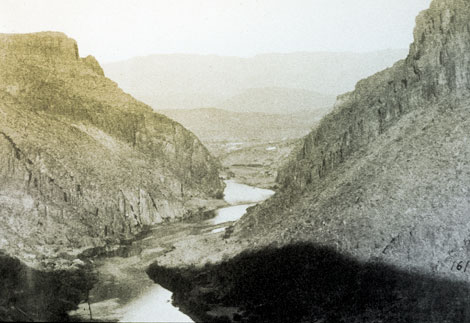 View up the Salt River Canyon below the site selected for Roosevelt Dam, 1904. The dam site was identified as early as 1889 by surveyors. (Reclamation photograph)
View up the Salt River Canyon below the site selected for Roosevelt Dam, 1904. The dam site was identified as early as 1889 by surveyors. (Reclamation photograph)Early Western settlers understood that there was water, but that it was not always available at the time or place necessary for agricultural or potable uses. Settlers responded by developing small-scale storage and irrigation projects, creating complicated Western water laws to allocate available water rights based on the concept of prior appropriation ("first in time, first in right"). Settlers diverted water from a stream or river and used it, but in many areas of the West, demand far outstripped supply. These early private and State-sponsored irrigation ventures often failed, however, because of lack of money or engineering expertise or both. Thus, as the 19th century moved into the 20th, pressure mounted for the Federal Government to intervene and assist in the development of Western water resources.
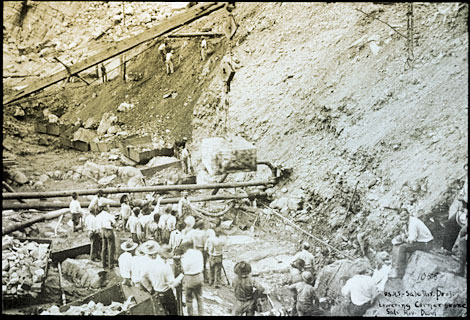 The cornerstone for Roosevelt Dam was laid September 20, 1906. (Reclamation photograph)
The cornerstone for Roosevelt Dam was laid September 20, 1906. (Reclamation photograph)On June 17, 1902, President Theodore Roosevelt signed the National Reclamation Act into law. Federal support for western water projects had not been an easy task because of Republican opposition and some politicians' fears that federally controlled water projects would threaten state water laws. After a long uphill battle in Congress, and more importantly with backing from President Roosevelt, support for the Reclamation Act gained momentum thanks to the efforts of two Senators: Henry Hansborough of North Dakota and Francis R. Newlands of Nevada. It passed both houses of Congress by wide margins. The National Reclamation Act is also known as the Newlands Act for the dogged support this Democratic senator gave towards its passage. Many thought it aptly named because it brought "new lands" under cultivation. Unlike the 1894 Carey Act, state and territorial governments had no role in implementing the National Reclamation Act. It did provide federal dollars and expertise to western states and territories to develop dams and irrigation projects; it "reserved" public lands served by irrigation projects to stop speculators from taking advantage of planned improvements; and it required farms receiving project water to be no larger than 160 acres. Perhaps most importantly for farmers in the Salt River Valley, the Act allowed private lands to receive water from federal projects.
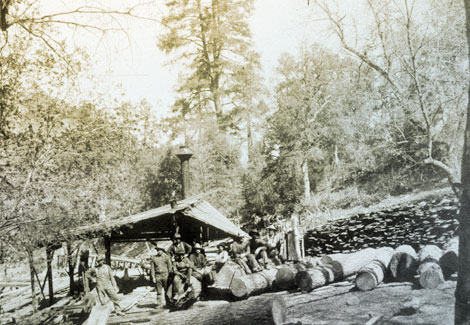 As construction got underway, the Reclamation Service established a lumber mill in the Sierra Ancha Mountains north of the Roosevelt Dam site. A local source for construction lumber was less expensive than hauling it from Mesa, 1904. (Reclamation photograph)
As construction got underway, the Reclamation Service established a lumber mill in the Sierra Ancha Mountains north of the Roosevelt Dam site. A local source for construction lumber was less expensive than hauling it from Mesa, 1904. (Reclamation photograph)Although an easterner by birth, President Roosevelt supported the reclamation movement because of his personal experiences in the West and his Progressive-era conservation ethic. To Roosevelt and the Progressives, conservation meant the sustained exploitation of natural resources through careful scientific management for the good of the many—an apt descriptor for the early reclamation movement in general. President Roosevelt also believed that reclamation equated homemaking. This rationale was a key argument for reclamation supporters, for they believed that a Government-sponsored reclamation program would make homes for Americans on small family farms, otherwise known as the "Jeffersonian Ideal."
Shortly after the Reclamation Act became law, Interior Secretary Ethan Hitchcock established the U.S. Reclamation Service within the U.S. Geological Survey's Division of Hydrography and named the Survey's Director Charles D. Walcott as Reclamation's chief. Relying on the Survey's previous studies of each western state and territory with Federal lands, the Reclamation Service studied potential projects. As a result of these studies, on March 14, 1903, Secretary Hitchcock authorized the first five Federal reclamation projects under Reclamation Service sponsorship: Newlands (Nevada), North Platte (Nebraska), Milk River (Montana), Uncompahgre (Colorado), and Salt River (Arizona Territory).
During its early years, the Reclamation Service established several basic operating principles. Over time, some details have changed, but the general principles remain:
- Federal monies spent on Reclamation Service projects that benefit water users would be repaid by the water users;
- Projects remained Federal property even after the water users repaid Federal construction costs;
- Reclamation Service contracted with the private sector for most construction work;
- Reclamation Service employees administered contracts to ensure that work done by contractors met Government specifications;
- In the absence of acceptable bids by contractors, Reclamation used its employees to complete a project;
- Hydroelectric power revenues are used to repay project construction charges (after 1930).
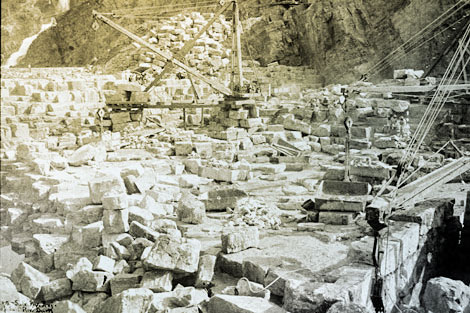 By 1907, construction of the Roosevelt Dam was well underway. (Reclamation photograph)
By 1907, construction of the Roosevelt Dam was well underway. (Reclamation photograph)In 1907 the Reclamation Service became an independent bureau within the Department of the Interior. There was a learning curve for the new agency, its employees, and Congress as they learned about the special economic and technical needs of Reclamation projects. They realized that many water users could not repay construction costs. Initially, Congress, overly optimistic about the construction cost repayments, set a 10-year repayment period. This requirement, however, proved unrealistic, and the limit was raised to 20 years, then 40 years, then finally the vague "ability to repay." Other financial woes included severe underestimation of construction costs and inflation's influence on those escalating costs.
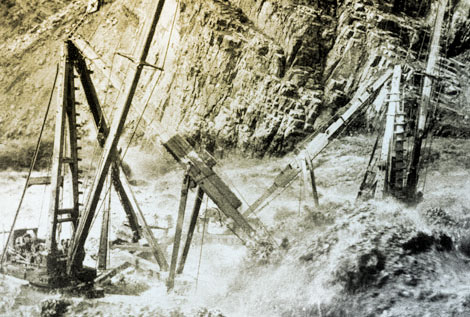 Flooding was a serious threat during Roosevelt Dam construction, 1908. (Reclamation photograph)
Flooding was a serious threat during Roosevelt Dam construction, 1908. (Reclamation photograph)Other issues underscoring the Reclamation Service's early learning curve included the interplay of science and economics, a relationship new to many farmers. There were soil science problems related to both construction and arability (the ability for soils to grow good crops); issues about the economic viability of some projects (repayment potential), including climactic limitations on crop values; problems with water saturation on irrigated project lands that resulted in expensive drainage systems as additional costs; and the need for practical farming experience for people to successfully work project farms. Many projects fell far behind in their repayment schedules, and settlers who once viewed the U.S. Reclamation Service as their savior started to voice discontent especially about the Service's excessive construction costs that related directly to the high repayment costs.
(Modified and adapted from: National Register of Historic Places Multiple Property Documentation Form, Salt River Project, Arizona, prepared by Jim Bailey, Bureau of Reclamation, June 2010; The Bureau of Reclamation: Origins and Growth to 1945, Volume 1. William D. Rowley, Bureau of Reclamation, Denver, 2006.)
